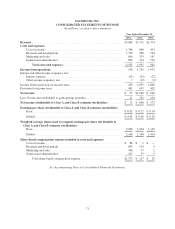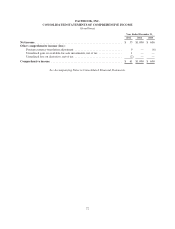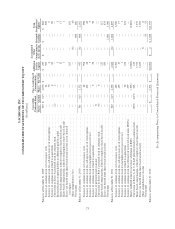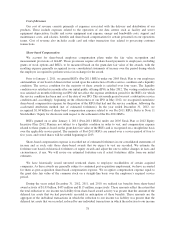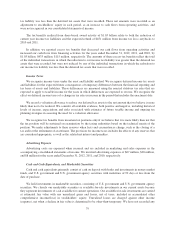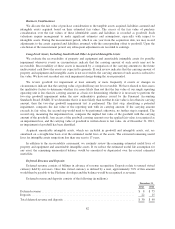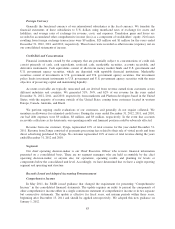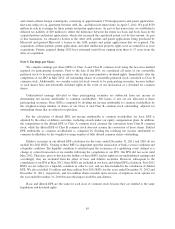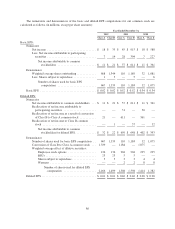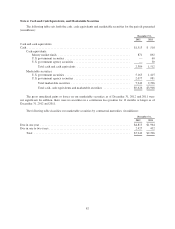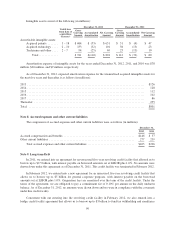Facebook 2012 Annual Report Download - page 84
Download and view the complete annual report
Please find page 84 of the 2012 Facebook annual report below. You can navigate through the pages in the report by either clicking on the pages listed below, or by using the keyword search tool below to find specific information within the annual report.such impairment charge in the periods presented. We determine realized gains or losses on sale of marketable
securities on a specific identification method, and record such gains or losses as other income (expense), net.
We classify certain restricted cash balances within prepaid expenses and other current assets and other
assets on the accompanying consolidated balance sheets based upon the term of the remaining restrictions.
Non-Marketable Securities
We invest in certain investment funds that are not publicly traded. We carry these investments at cost
because we do not have significant influence over the underlying investee. We assess for any other-than-
temporary impairment at least on an annual basis. No impairment charge has been recorded to-date on our non-
marketable securities. We classify these investments within other assets on the accompanying consolidated
balance sheets.
Derivative Financial Instruments
We account for derivative instruments as either assets or liabilities and carry them at fair value. For
derivative instruments that hedge the exposure to variability in expected future cash flows that are designated as
cash-flow hedges, the effective portion of the gain or loss on the derivative instruments is initially reported as a
separate component of accumulated other comprehensive income (AOCI) in shareholders’ equity and is
subsequently recognized in earnings when the hedge exposure is recognized in earnings. The ineffective portion
of the gain or loss on the derivative instruments, if any, is recognized in earnings. To receive hedge accounting
treatment, a cash flow hedge must be highly effective in offsetting changes to expected future cash flows on the
hedged transaction.
In October 2012 we entered into an interest rate swap agreement to hedge our exposure to interest rate
fluctuation with respect to our $1.5 billion floating rate three-year unsecured term loan facility. The critical terms
of the interest rate swap agreement and the related debt agreement match and allow us to designate the interest
rate swap as a highly effective cash flow hedge under GAAP. We periodically assess the effectiveness of our
hedged transaction. The interest rate swap agreement is currently our only derivative instrument and is not used
for trading purpose. Refer to Note 9 Long-term Debt for further disclosure on the interest rate swap agreement.
Fair Value of Financial Instruments
We apply fair value accounting for all financial assets and liabilities and non-financial assets and liabilities
that are recognized or disclosed at fair value in the financial statements on a recurring basis. We define fair value
as the price that would be received from selling an asset or paid to transfer a liability in an orderly transaction
between market participants at the measurement date. When determining the fair value measurements for assets
and liabilities, which are required to be recorded at fair value, we consider the principal or most advantageous
market in which we would transact and the market-based risk measurements or assumptions that market
participants would use in pricing the asset or liability, such as risks inherent in valuation techniques, transfer
restrictions and credit risk. Fair value is estimated by applying the following hierarchy, which prioritizes the
inputs used to measure fair value into three levels and bases the categorization within the hierarchy upon the
lowest level of input that is available and significant to the fair value measurement:
Level 1 – Quoted prices in active markets for identical assets or liabilities.
Level 2 – Observable inputs other than quoted prices in active markets for identical assets and liabilities,
quoted prices for identical or similar assets or liabilities in inactive markets, or other inputs that are observable or
can be corroborated by observable market data for substantially the full term of the assets or liabilities.
Level 3 – Inputs that are generally unobservable and typically reflect management’s estimate of assumptions
that market participants would use in pricing the asset or liability.
80



